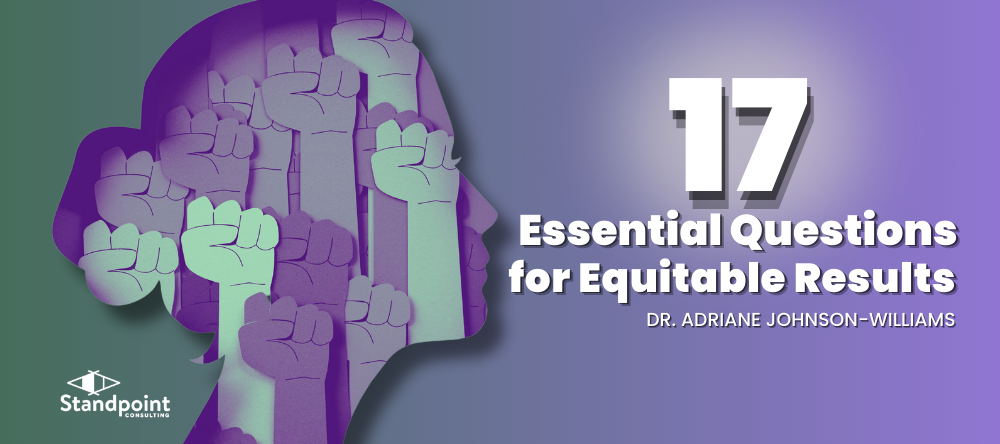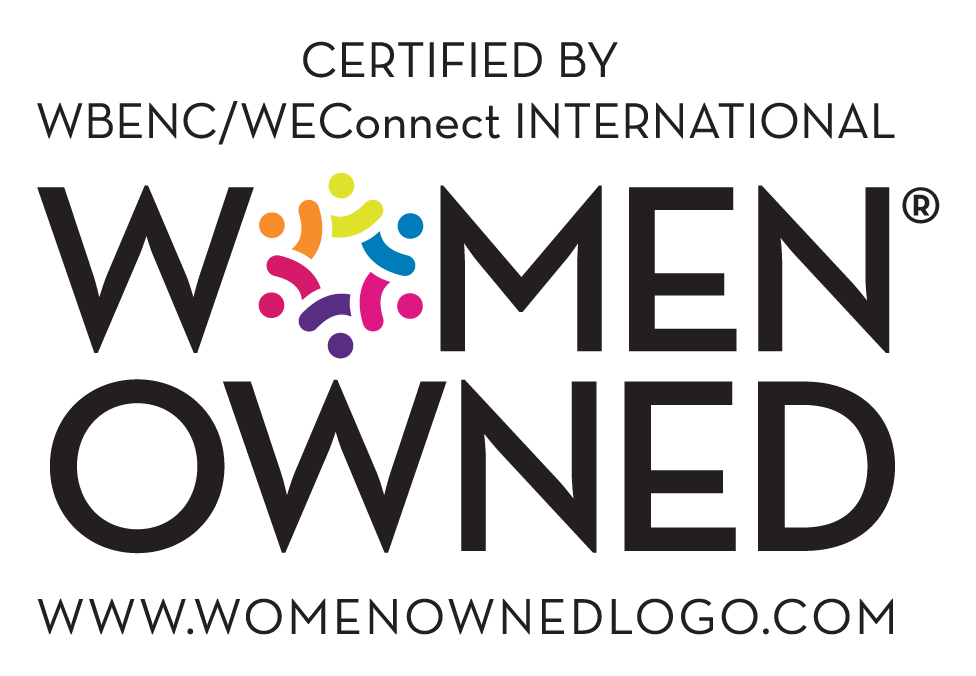
Whether you are working for profit, human benefit, and/or social change, you probably want to have an impact. You’re likely working toward a result of some sort. (If you aren’t, we should definitely talk.) Making an impact or pursuing results of any kind requires a plan. The best plans provide answers to questions that may be deceptively simple. Here are 17 questions adapted from the Equitable Results Sequence of the Annie E. Casey Foundation’s Results Count ® framework. If you’d like some support answering these questions in your organization, Standpoint Consulting is happy to help.
- To what grand vision of the world do you want to contribute?
Making an impact means having a vision. A grand one. Sometimes organizations create visions, which focus on themselves or are limited to a tiny corner of their sector. Don’t create a vision only you can work toward. Create one that can serve as a beacon for others. They may not buy into your mission—how you plan to pursue the vision––but they may begin their own work that furthers your vision. A grand vision lays the foundation for grand partnerships and collaborations and serves as a beacon for others.
- Who is most burdened by systems implicated in the vision?
If you want to achieve an equitable result, you must determine which group of people are farthest from the vision as well as those who need what you’re offering more than others. This is where you can make an impact.
- What is standing in the way of your vision?
Your strategies can reduce or eliminate barriers. First, you need to identify them.. Take time to brainstorm all the things you see as obstacles. The more perspectives the better. Then, do what’s necessary to invalidate them. If they survive the process, those are a great place to start.
- What exists that is already in support of your vision?
Sometimes you want to eliminate barriers, but sometimes it’s best to accentuate the good stuff. Again, brainstorm what the good stuff is and work to prove yourself wrong. Include as many informed people as possible. And set aside the surviving ideas.
- What are the barriers and supports that are different from the group that is farthest from your vision?
The group you identified that will make sure you focus on equity needs some special attention. They need their own brainstorming efforts. Something is pushing or keeping them farther away from the vision. If that weren’t true, they wouldn’t stand out.
- What path do we take?
The path is the set of strategies you adopt. To make progress toward your vision, you’ll need to make sure those strategies are designed to address the barriers and/or supports that have survived the gauntlet of your brainstorm-invalidation process. To make that progress equitable, prioritize the items that survived, which are related to the most distant group.
- With whom do we take this path?
If your organization can make the progress you want alone, skip this question. If not, it’s going to be vital to identify the right collaborators, maybe even partners. It’s best to seek collaborators who are positioned to support your strategies. It’s easy to say, ORG A shares our values or ORG B has a similar mission, but those commonalities are not a foundation for a strong collaboration. Delta doesn’t need to partner with Spirit because they both fly passenger planes, but they do benefit from partnerships with regional carriers willing to be subject to their branding and fly only their passengers. Your collaborators need to be doing work that will help you effectively pursue your strategies. Focusing your collaborations at that level will create relationships more beneficial for all parties. Of course, you need to bring something to the table for them as well. No successful relationship is one-sided.
- Which organizations and/or people do you work with directly?
Another consideration for collaboration is whether potential partners already serve the same population as you do. For instance, it doesn’t align for an air travel company to partner with a homebuilding firm. While there are most certainly home builders who seek to provide excellent customer service, as does Delta, that doesn’t mean they will help keep air travelers happy.
- Which of those groups focus on that special population you’re targeting?
You’ve identified a group that is more distant from your vision than others. If you don’t have a great deal of expertise with that group, or if you identify a hole in your organization, it’s a great time to develop a strategic relationship. It may even rise from the level of collaboration to form a legal partnership.
- How does each unit contribute to the strategies?
No matter how powerful or highly aligned the strategy, it won’t come to life without the people. At the division/department/team level, the ways in which each contributes to the strategies must be crystal clear. There can be no ambiguity about what they, and no one else, are authorized to do regarding each strategy to which they contribute.
- How does each role contribute to the strategies?
In units, each role needs to have the same level of clarity. Notice here, that the language is role not person. The most singular organizational unit is the role. Often, many people are able to fill the same role, and there needs to be as little variation as possible in what that role contributes to the strategies.
NOTE: This is where aligning for impact may crash into poor organizational practices, like generic job titles, and job descriptions. It’s also an opportunity to ensure that HR departments are constantly reassessing how to define roles in alignment with strategy.
- How will we know whether our plan is working?
You’ll measure. Performance measures, as annoying as they may be in your organization, have a vital purpose. But, keep them simple. Start with developing four performance measures for each strategy and for the complex tactics. If those four don’t give you the information you need, add one. Very large organizations, with organization level and division/department/unit level strategies, will have more performance measures than smaller organizations. Those measures should answer the next four questions, which come from Michael Friedman’s Working Hard is Not Good Enough.
Taking measures is Step 1. You have to use measures, when they are available, to determine if changes are needed–daily, weekly, or quarterly. Whatever the period of data availability, you need to be looking at it and talking about it. The changes won’t be as regular, but you’ll have enough information to determine when those changes are necessary. So add that review schedule to your plan.
- How is anyone better off?
The answer to this question is the first sign you are making progress toward your vision. This measure must connect to that vision.
- How is our work making a difference?
Within a given strategy, you need to measure the impact of your work. For example, people are arriving at their locations alive and on time because your planes are safe and your systems ensure things run smoothly. Those seeking high school equivalency (HSE) are passing their exams because your programs are well-designed and delivered.
- How well are we doing?
This is a basic customer service or early-stage effectiveness measure. The more regularly you can collect and examine this, the better. For instance, you can establish metrics on the percentage of repeat passengers on a given route, the percentage of one-time departures within a given time period, the attendance rates of HSE seekers, or the persistence rates of HSE seekers.
- How much are we doing?
This is simple counting, but it’s an important step in the process, which provides the foundational data for all other performance questions. Some of these could include the number of passengers in a given time period, on a given route, the number of on-time departures or the number of HSE seekers.
- What values are revealed in our plan?
Some people begin their planning processes by establishing a set of values. I prefer to identify values at the end of a planning process because they are the ones that an organization actually holds. Examining the plan for values gives internal planners the opportunity to decide if the values in their plan accurately represent the core values of the organization. If the values are not as anticipated, they have the opportunity to make changes.
These 17 questions work for short- and long-term planning. They work for organizations of any size, and with some key sector-specific adjustments, they are sector agnostic.
If you’d like some support answering these questions in your organization, Standpoint Consulting is happy to help.

About the author:
Dr. Adriane Johnson-Williams is a native Memphian dedicated to improving the lives of Black and Brown people in her hometown and ultimately, across the nation. She is Founder and Principal at Standpoint Consulting, a firm that delivers curated, results-based support that helps businesses and organizations bridge the gap between people who make decisions and people who must live with the decisions being made.
Dr. Johnson-Williams serves as board chair and co-founder of Whole Child Strategies, Inc., an organization working to amplify the voices of children and families in solving the challenges they are confronting in disinvested neighborhoods. She also serves on the International Coaching Federation Tennessee affiliate (ICFTN) board. As an alumna of Girls, Inc. of Memphis, she has always had a special place in her heart for the organization and its mission of helping all girls be strong, smart, and bold. She is the first alumna to serve as the Memphis affiliate’s board chair and currently serves on the Girls, Inc. national board.
In 2020, Dr. Johnson-Williams was named Woman of the Year for Girls Inc. of Memphis, and she received the Evelyn S. Field Award from SisterReach for demonstrating Reproductive Justice at the Intersections. In 2021, the Memphis Business Journal named her a Super Woman in Business. In 2023, Dr. Johnson-Williams published her first book, Not Your Father’s Capitalism, a map and detailed guidance for U.S. business leaders pursuing race equity within their organizations.



